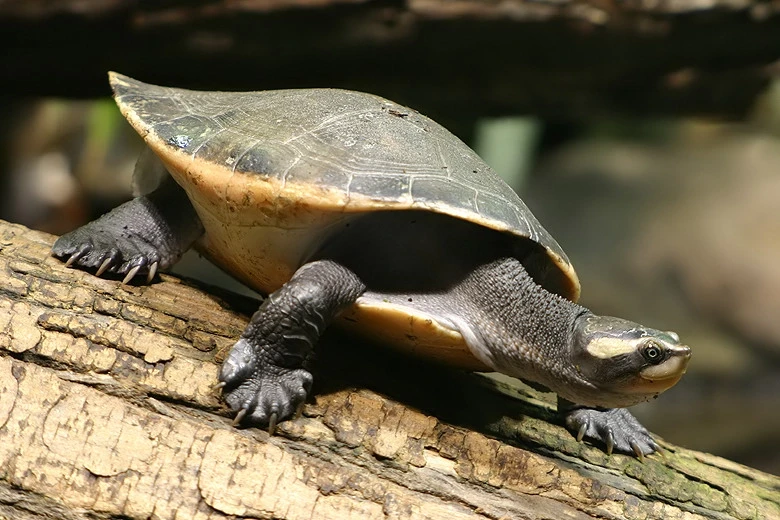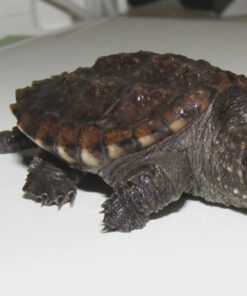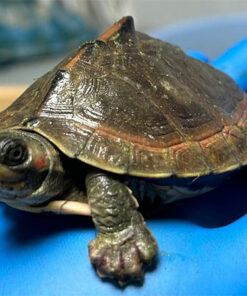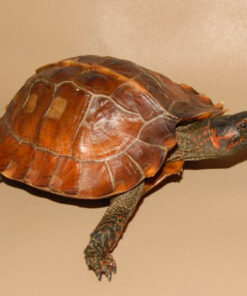$149.99
Baby Red Faced Short Neck Turtle for Sale a colorful Pinkbelly Sideneck Turtle alternative. Feeds on turtle pellets, shrimp, bloodworms.
Language: US English
Category: TURTLES FOR SALE
Red Faced Short Neck Turtle For sale: A Unique Addition to Your Turtle Collection
The **Baby Red Faced Short Neck Turtle** (*Emydura australis*) is an attractive, lesser-known species of freshwater turtle hailing from Australia. Their distinct appearance, marked by a bright red or pink hue on the face and a shorter-than-average neck, makes them a fascinating addition to any reptile collection. These turtles are relatively easy to care for, active, and a joy to watch, making them an excellent choice for both beginner and experienced turtle enthusiasts.
If you’re interested in owning one of these incredible creatures, it’s essential to understand their care requirements, natural habitat, and where to **buy Baby Red Faced Short Neck Turtles**. This guide will provide everything you need to know to help your new turtle thrive in your home.
What is a Baby Red Faced Short Neck Turtle?
Red Faced Short Neck Turtle belongs to the family Chelidae and is native to the freshwater rivers, streams, and lakes of Northern Australia. This species is often recognized for its vivid red or pink facial markings, which fade slightly as the turtle matures, but remain prominent, giving it its characteristic name. The short neck, in comparison to other Australian turtle species like the long-necked turtle, further sets them apart visually.
Baby Red Faced Short Neck Turtles are hardy creatures, with the ability to adapt well to captivity. They are active swimmers and spend much of their time in the water, though they also enjoy basking. These turtles can live for decades, making them a long-term commitment but also a rewarding companion for dedicated turtle keepers.
Key Characteristics of Baby Red Faced Short Neck Turtles
– **Size**: At birth, these turtles are about 1 to 2 inches long, but they can grow up to 6 to 9 inches as adults.
– **Coloration**: The most striking feature is the red or pink markings on their face, which contrast against the more subdued colors of their brown or greenish-gray carapace (top shell) and plastron (bottom shell).
– **Neck Length**: As their name implies, they have a short neck compared to other species, giving them a compact and streamlined look.
– **Behavior**: They are very active and spend a significant amount of time swimming or basking, which makes them fun to observe.
Why Choose a Baby Red Faced Short Neck Turtle?
The Red Faced Short Neck Turtle is an appealing choice for anyone looking to add a unique species to their reptile collection. Unlike some of the more common turtle species, their striking appearance sets them apart, making them a conversation starter for any turtle enthusiast. Moreover, they are relatively easy to care for, provided their basic needs are met.
Their size also makes them suitable for indoor setups, as they don’t require as large of an enclosure as some other freshwater turtles. Additionally, they are hardy and can adapt to a variety of conditions, making them an excellent choice for beginners or those looking to expand their existing collection.
Natural Habitat and Behavior
In the wild, Red Faced Short Neck Turtles inhabit slow-moving freshwater rivers, streams, and lakes. They prefer clear waters with plenty of aquatic vegetation and places to hide. As semi-aquatic turtles, they spend the majority of their time in the water but will come onto land to bask in the sun, an essential behavior for maintaining their health.
Understanding their natural habitat is crucial for recreating a suitable environment in captivity. Proper care involves replicating these conditions as closely as possible to ensure that your turtle thrives in your home setup.
Habitat Setup for Baby Red Faced Short Neck Turtles
Before purchasing a Red Faced Short Neck Turtle for sale, it’s essential to create an ideal habitat that closely mimics their natural environment. Here’s a breakdown of the key elements:
### 1. **Tank Size**
While baby turtles can be housed in smaller enclosures, it’s best to plan for their adult size from the start. A 40 to 55-gallon tank is suitable for one Red Faced Short Neck Turtle, but as they grow, you may need a larger enclosure to accommodate their activity levels. Providing ample space will ensure they remain healthy and active.
### 2. **Water Quality**
Water quality is critical for the health of your turtle. Invest in a high-quality filtration system that keeps the water clean and free from harmful bacteria. These turtles are primarily aquatic, so maintaining clean water is vital to prevent infections or diseases.
The water temperature should be kept between 75°F and 82°F. A submersible water heater can help maintain consistent temperatures, especially in colder climates.
### 3. **Basking Area**
Turtles need a dry basking area where they can climb out of the water to dry off and absorb heat. You can create a basking area using a floating dock or flat rocks. The basking spot should be under a heat lamp that keeps the temperature around 85°F to 90°F.
### 4. **Lighting**
In addition to a heat lamp for basking, your turtle will need access to UVB lighting. UVB light is essential for turtles to synthesize vitamin D3, which helps them absorb calcium and maintain a healthy shell. Ensure that your UVB light is placed over the basking area and is on for 10-12 hours a day to replicate natural sunlight.
### 5. **Substrate and Decorations**
For the bottom of the tank, smooth river rocks or large pebbles are good choices, as they are easy to clean and reduce the risk of ingestion. You can also add aquatic plants, driftwood, and other decorations to make the habitat more natural and stimulating for your turtle.
Aquatic plants not only add visual appeal but also provide hiding spots for the turtles, making them feel more secure in their environment.
Diet and Feeding
** Red Faced Short Neck Turtles for sale are omnivores, which means they eat both plant and animal matter. In the wild, they feed on a variety of aquatic vegetation, insects, and small fish. In captivity, you should provide them with a balanced diet that replicates their natural feeding habits.
### 1. **Protein Sources**
As young turtles, they require a diet rich in protein to support their growth. Offer them:
– **Commercial Turtle Pellets**: These pellets are formulated to meet the nutritional needs of aquatic turtles and can serve as the primary diet.
– **Insects and Worms**: Mealworms, crickets, and bloodworms are excellent sources of protein for growing turtles.
– **Small Fish**: Occasional feeder fish like minnows or guppies can be added to the diet as a treat.
### 2. **Vegetation**
As your turtle matures, you should introduce more plant-based foods into its diet. Some good options include:
– **Leafy Greens**: Romaine lettuce, dandelion greens, and kale can be offered regularly.
– **Aquatic Plants**: You can add live or cut aquatic plants like water lettuce or duckweed, which your turtle can nibble on throughout the day.
### 3. **Calcium Supplements**
To ensure healthy shell growth, dust your turtle’s food with a calcium supplement 2-3 times a week. This is particularly important for young turtles that are still growing, as a lack of calcium can lead to metabolic bone disease and other health issues.
### 4. **Feeding Schedule**
Baby turtles should be fed once a day, and you can reduce feeding frequency to every other day as they mature. Ensure that all uneaten food is removed from the water after feeding to maintain water quality.
## Health and Common Issues
While ** Red Faced Short Neck Turtles for Sale ** are relatively hardy, they can still experience health problems if their care isn’t properly managed. Here are a few common health concerns to watch out for:
### 1. **Shell Rot**
Shell rot is a bacterial infection that affects the shell, causing discoloration, soft spots, and a foul odor. It’s often the result of poor water quality or the turtle not being able to dry off properly. Prevent shell rot by maintaining clean water and providing a dry basking area where the turtle can dry completely.
### 2. **Respiratory Infections**
If the water or air temperature is too cold, your turtle could develop a respiratory infection. Symptoms include lethargy, wheezing, and nasal discharge. Keep the water and basking areas at the proper temperatures to prevent this condition.
### 3. **Vitamin Deficiencies**
A poor diet lacking in variety can lead to vitamin deficiencies, particularly vitamin A. A deficiency in vitamin A can cause swelling around the eyes and other health issues. Providing a balanced diet with a mix of protein and plant matter, as well as vitamin supplements, will help prevent this.
Behavior and Temperament
The ** Red Faced Short Neck Turtle** is known for being active and alert. They are curious creatures, often seen swimming energetically or basking under their heat lamp. Although they are not particularly aggressive, they can be shy when first introduced to a new environment or when handled too often.
These turtles generally do well in pairs or groups, provided there is enough space to accommodate them. If you plan to house multiple turtles together, make sure there are plenty of basking spots and hiding places to reduce stress and competition.
Where to Buy Baby Red Faced Short Neck Turtles
If you’re looking to **buy Baby Red Faced Short Neck Turtles**, it’s important to choose a reputable seller who prioritizes the health and well-being of their animals. At **NewYorkReptiles.com**, we take pride in offering healthy, captive-bred turtles that are raised in optimal conditions. When purchasing from a reliable source, you can be confident that your turtle will arrive in good health and be ready to thrive in its new home.
Conclusion
The **Baby Red Faced Short Neck Turtle** is a unique, hardy, and visually stunning species that makes a great pet for reptile enthusiasts of all levels. With their bright red facial markings, active behavior, and relatively simple care requirements, these turtles are a joy to own. By following the guidelines in this article and purchasing from a reputable source, you can ensure that your new turtle will live a long, healthy, and happy life in your care.
Be the first to review “Baby Red Faced Short Neck Turtle for Sale – Exotic Pets at 2 Inches Length” Cancel reply
Related products
TURTLES FOR SALE
$149.99
TURTLES FOR SALE
Red Ear Slider Turtle for sale | #1 Best Exotic Pets for Sale
$1,199.99
Sale!
TURTLES FOR SALE
TURTLES FOR SALE
Baby Indian Brown Roofed Turtle for Sale | #1 Best exotic Reptiles
$349.99
TURTLES FOR SALE
$274.99
TURTLES FOR SALE
$199.99
TURTLES FOR SALE
$249.99























Reviews
There are no reviews yet.